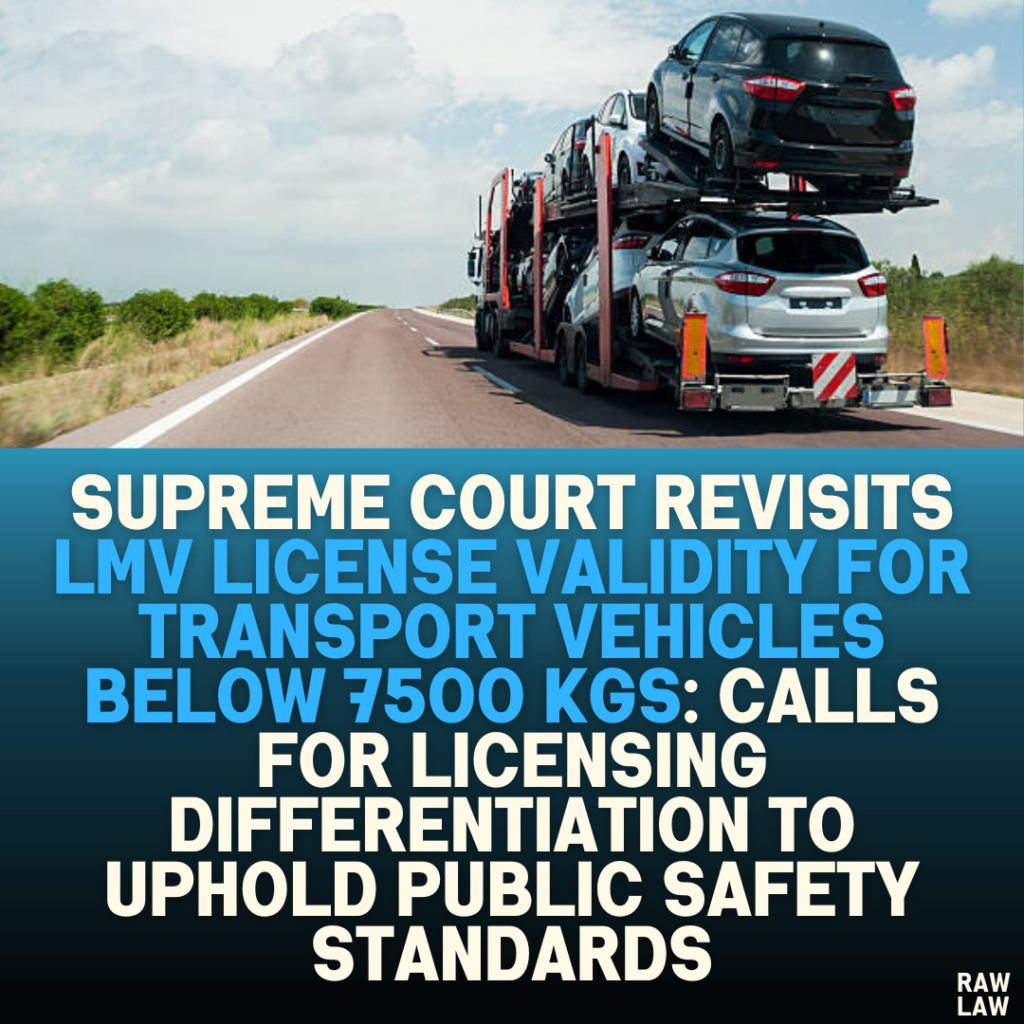Court’s Decision:
The Supreme Court, in examining whether a Light Motor Vehicle (LMV) license allows driving of transport vehicles below 7500 kgs without specific endorsement, questioned the precedents set by the Mukund Dewangan case, which had upheld that a separate license endorsement was unnecessary. The Court’s deliberation centers on balancing road safety with livelihood implications for drivers.
Facts:
This case arose after the two-judge bench decision in Mukund Dewangan v. Oriental Insurance Co. Ltd., where the Supreme Court had concluded that a driver with an LMV license could operate transport vehicles if their weight did not exceed 7500 kgs, without requiring a special endorsement for “transport vehicles.” However, concerns emerged over the safety and legal interpretation of licensing requirements under the Motor Vehicles Act (MV Act), prompting a referral to a larger bench.
Issues:
- Whether a holder of an LMV license under Section 10(2)(d) of the MV Act can operate a transport vehicle without endorsement under Section 10(2)(e).
- If the stipulations in Section 3(1) for a “transport vehicle” license override the LMV definition in Section 2(21) of the MV Act.
- Whether the requirements for a transport vehicle license should apply to those licensed for LMVs driving vehicles under 7500 kgs.
- The impact of the 1994 amendments consolidating categories under “transport vehicle.”
- Whether the Mukund Dewangan decision missed relevant provisions, potentially rendering it per incuriam.
Petitioner’s Arguments:
The petitioners, representing insurance companies, contended that the MV Act distinctly categorizes LMVs and transport vehicles, with separate requirements for each. They argued that Mukund Dewangan overlooked critical provisions, specifically Sections 3 and 4, which mandate a separate endorsement for driving transport vehicles. They highlighted that the act’s rigorous standards for transport licenses are integral to public safety, asserting that road safety considerations and the protection of insurance frameworks warrant strict adherence to these statutory distinctions.
Respondent’s Arguments:
The respondents, representing the claimants, argued that the statutory language in Section 2(21) unambiguously includes transport vehicles within the LMV definition based on weight, aligning with the current licensing system. They argued that altering this interpretation would disrupt livelihoods and economic stability for drivers dependent on LMV licenses. They also stressed the relevance of legislative intent, emphasizing that the Act’s evolution points to simplification through classification by weight.
Analysis of the Law:
The MV Act’s classification approach includes distinctions based on vehicle type and usage, reflecting both weight-based and usage-based licensing. The debate hinges on whether statutory interpretation should focus strictly on textual definitions or consider broader public safety objectives embedded within the Act’s framework. Legal principles of “Generalia Specialibus Non Derogant” (general provisions do not derogate from specific ones) suggest that the special licensing regime for transport vehicles should hold precedence over general LMV classification.
Precedent Analysis:
The Court examined past interpretations, including the Mukund Dewangan ruling and subsequent cases that brought to light the distinct requirements for transport licenses under various MV Act provisions. Notably, the Court reviewed the Nathi Devi case, emphasizing that statutory language should uphold each legislative term’s meaning without omissions that compromise safety standards.
Court’s Reasoning:
The Court highlighted that the statutory scheme demands differentiation in licensing for transport vehicles given the added responsibility of public carriage. It reasoned that LMV holders might not meet the requisite competence and medical standards specified for transport drivers, thus necessitating separate endorsements to safeguard road users.
Conclusion:
Pending further arguments and government consultation, the Court tentatively signaled the need for a fresh examination of licensing laws, considering evolving transportation needs, road safety, and the socioeconomic impacts on drivers. It deferred the decision until a detailed assessment of policy perspectives from the Union Government could be obtained.
Implications:
The outcome of this case could redefine the permissible scope for LMV licenses and potentially prompt legislative reforms to clarify licensing standards. This interpretation may significantly impact insurance policies, driver eligibility, and road safety regulations, especially for transport vehicles within the LMV weight threshold.



